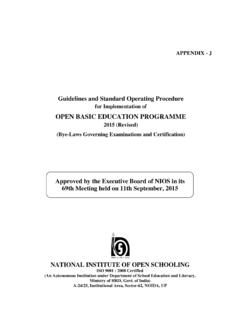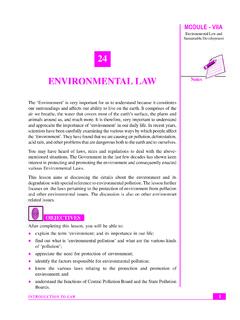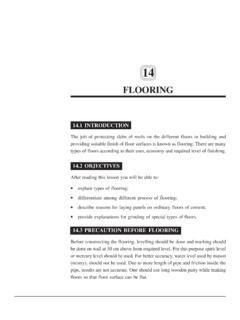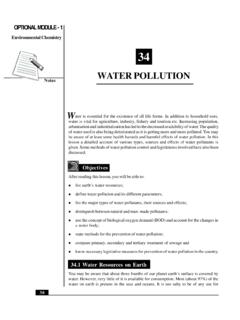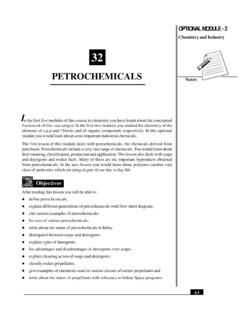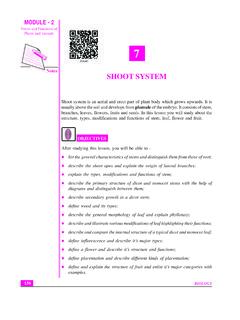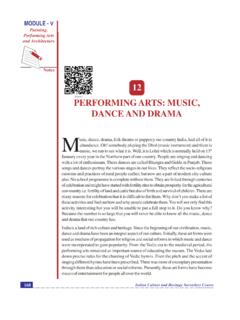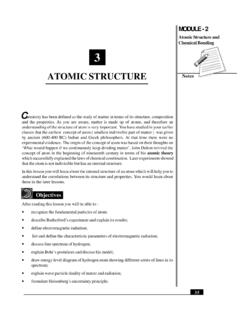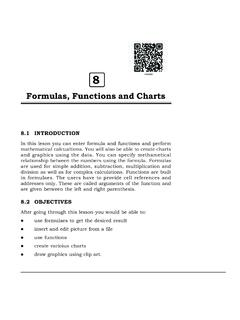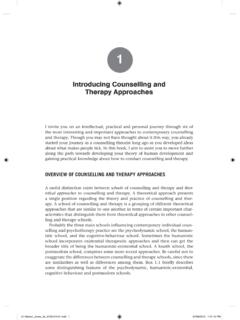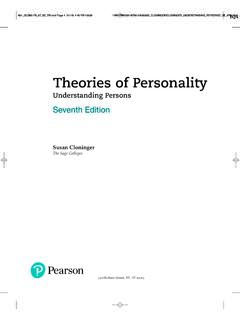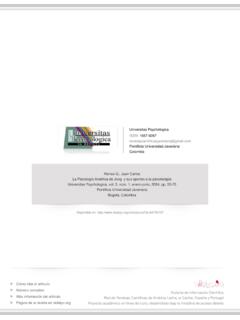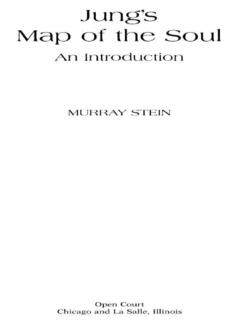Transcription of PERSONALITY THEORIES
1 95 PSYCHOLOGYP ersonality TheoriesNotesMODULE-IVSelf and Personality1818181818 PERSONALITY THEORIESE very one of us shares many things with others. However, apart from commonalitieswe also find that people are different in the way they appear and behave. Thestudy of PERSONALITY deals with the issue of human individuality. It has attracted theattention of common man as well as academic a human being each one of us shows certain specific patterns of thinking,feeling and acting. They represent who we are and provide the basis of ourinteraction with other individuals. In everyday life we often find people who arecalled aggressive , jolly , happy and so on. These are impressions of peoplewhich we carry with us and use while interacting with them. It is in this sense thatwe frequently employ the word PERSONALITY .
2 The study of PERSONALITY has alsoattracted the attention of psychologists and they have developed various theoriesof PERSONALITY . Also, they have developed certain tools to assess people spersonality. The PERSONALITY related information is used in selecting people forvarious jobs, giving guidance to people in the need of psychological help, andmapping their potential. Thus the study of PERSONALITY contributes to different areasof human behaviour. This chapter will help you learn about different aspects ofpersonality. OBJECTIVESA fter studying this lesson, you will be able to: Describe the concept of PERSONALITY ; Explain psycho-analytic, trait, social-cognitive, and humanistic THEORIES ofpersonality; Explain the concept of three gunas and familiarize with the ways of assessingpersonality; and Describe the factors influencing PERSONALITY TheoriesNotes96 MODULE -IVSelf and PERSONALITY CONCEPT OF PERSONALITYThe term PERSONALITY is used in a number of ways including the apparent featuresof a person.
3 However, psychologists use it to refer to the characteristic patternof thinking, feeling and acting. By characteristic pattern we mean theconsistent and distinctive ways our ideas, feelings and actions areorganized. When we talk about PERSONALITY we usually refer to the totality orwhole of the person. Thus, the enduring pattern expressed by the person in varioussituations is the hall mark of PERSONALITY . Interestingly the THEORIES of PERSONALITY gobeyond the literal meaning of PERSONALITY which stands for large masks used byactors in ancient Greek drama. Contrary to this the PERSONALITY theorists view PERSONALITY as the essence of the person. It is a person s true inner nature. Theunique impression that a person makes on others is equally important inunderstanding PERSONALITY .
4 However the concept of PERSONALITY has been definedby psychologists in many ways and it is the theoretical perspective or positionwhich directs our attention to particular aspects of PERSONALITY has proved to be a difficult and challenging task. It s socomplex that no single theory is able to cover the total PERSONALITY . The differenttheories approach the structure and functioning of PERSONALITY from differentpositions. There are many THEORIES of PERSONALITY each provides different answersabout the way they treat the issues about PERSONALITY functioning. In particular,they provide different explanations about the role of conscious/ unconscious factors,determinism/freedom in functioning, role of early experience, role of genetic factors,uniqueness/universality etc. In the present lesson you will learn about four majortheoretical perspectives of PERSONALITY .
5 They include psychoanalytic, trait, humanisticand social-cognitive perspectives. THE PSYCHOANALYTIC PERSPECTIVEF ounded by Sigmund Freud, this theory emphasizes the influence of theunconscious, the importance of sexual and aggressive instincts, and early childhoodexperience on a person. This theory has been very influential not only in psychologybut also in literary circles, art, psychiatry and films. Many of Freud s ideas havebecome part and parcel of every day usage. Freud started his career as aneurologist. His theory developed in the course of his observations of his patients,as well as, self analysis. He used free association to help his patients recoverforgotten discovered that mind is like an iceberg and we have limited TheoriesNotesMODULE-IVSelf and PersonalityFreud proposed that psychological forces operate at three levels of awareness:Conscious level: The thoughts, feelings, and sensations that one is aware of atthe present level: It contains information of which one is not currently aware,however, they can easily enter conscious level: It consists of thought, feelings, wishes, drives etc.
6 Of whichwe are not aware. It, however, influences our conscious level of thought that unconscious material often seeks to push through to the consciouslevel in a disguised manner. It may be in a distorted manner and or it may take asymbolic form. Interpretation of dreams and free association were used for analysisof the three levels of StructureFreud believed that human PERSONALITY emerges due to a conflict between ouraggressive and pleasure seeking biological impulses and the internalized socialrestraints against them. Thus, PERSONALITY arises in the course of our effort to resolvethe conflicts. To this end he proposed three structures which interact with eachother: Id, Ego and Super Ego. Let us learn about these structures:Id: It is the unconscious , irrational part of PERSONALITY .
7 It is the primitive part immuneto morality and demands of the external world. It operates on the pleasure seeks immediate : It is involved with the workings of the real world. It operates on the realityprinciple. It is the conscious, and rational part of PERSONALITY that regulates thoughtsand behaviors. It teaches the person to balance demands of external world andneeds of the Ego: It is the internal representation of parental and societal values. Itworks as the voice of conscience, that compels the ego to consider not only thereal but also the ideal. It judges one s behaviors as right or wrong, good or up to moral ideals bring about the shame, guilt, inferiority and anxiety in DevelopmentOn the basis of case-history of patients, Freud reached at a conclusion thatpersonality development occurs through a sequence of psychosexual stages.
8 Inthese stages the Id s pleasure seeking tendency focuses on different areas of shows these TheoriesNotes98 MODULE -IVSelf and : Stages of Psychosexual DevelopmentStagesFocus of activityOralPleasure centers in the mouth and leads to(0-18 months)activities of sucking and biting centers on bowel and bladder(18-36 months)eliminationPhallicPleasure centre is genitals(4 to 6 years)Touching and fondling of genitals give pleasureLatencyChildren repress their sexual impulses and(7 to 11 years)channelize them into socially acceptableactivities such as sports, zone is the genital.(From the onset of puberty)Maturation of sexual interestsDefense MechanismsThe Ego has to perform a difficult duty of mediating between the instinctual demandsof Id and moral position of Super Ego. The Ego tries to solve the problem and if arealistic solution or compromise is not possible it indulges in distorting thoughts orperception of reality through certain processes called defense mechanisms.
9 Todefend or safeguard ourselves, we use technique called defense mechanism. Theseare also called Adjustment Mechanisms. Some of the key mechanisms are givenbelow:MechanismDescriptionDenialFai lure to recognize or acknowledge the existenceof unpleasant event/information as I do not know,I have not seen impulses are redirected toward oneother substitute person/objectProjectionAttributing own unacceptable urges to othersRationalizationJustifying our actions or feelings through sociallyacceptable explanationsReaction formationThinking or acting in a way that is the extremeopposite of unacceptable urgesRegressionRetreating to behaviour characteristic of anearlier stage of developmentRepressionExclusion of anxiety producing thoughts, feelingsor impulses from consciousnessSublimationSexual urges are channelized into productive.
10 Nonsexual activities99 PSYCHOLOGYP ersonality TheoriesNotesMODULE-IVSelf and PersonalityFreud s ideas have been controversial. The neo-Freudians differed from Freud ona number of issues. Some of the key theorists who are included in this categoryare listed jung : collective UnconsciousJung was opposed to the central role of sex and aggression in human life. Insteadhe proposed that people are motivated by more general psychological energy. Heproposed that the deepest part of one s psyche comprises the collectiveunconscious. It is a set of influences inherited from our family and the human collective unconscious contains archetypes which are the mental images of aparticular person, object or experience. Hero, powerful father, innocent child,nurturant mother are example of Horney: Basic AnxietyHorney emphasized on the importance of social relationships in personalitydevelopment.
